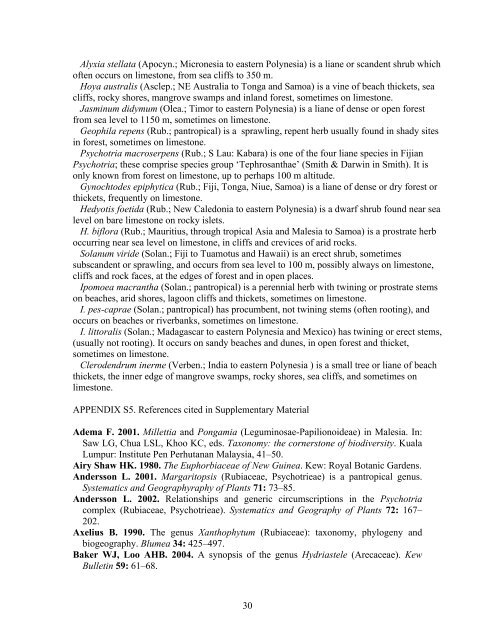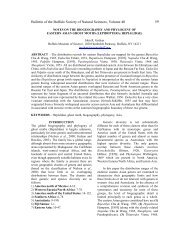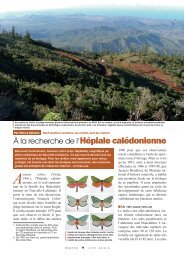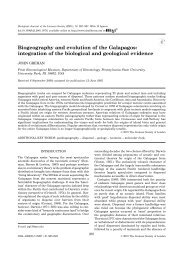You also want an ePaper? Increase the reach of your titles
YUMPU automatically turns print PDFs into web optimized ePapers that Google loves.
Alyxia stellata (Apocyn.; Micronesia to eastern Polynesia) is a liane or scandent shrub which<br />
often occurs on limestone, from sea cliffs to 350 m.<br />
Hoya australis (Asclep.; NE Australia to Tonga and Samoa) is a vine of beach thickets, sea<br />
cliffs, rocky shores, mangrove swamps and inland forest, sometimes on limestone.<br />
Jasminum didymum (Olea.; Timor to eastern Polynesia) is a liane of dense or open forest<br />
from sea level to 1150 m, sometimes on limestone.<br />
Geophila repens (Rub.; pantropical) is a sprawling, repent herb usually found in shady sites<br />
in forest, sometimes on limestone.<br />
Psychotria macroserpens (Rub.; S Lau: Kabara) is one of the four liane species in Fijian<br />
Psychotria; these comprise species group ‘Tephrosanthae’ (Smith & Darwin in Smith). It is<br />
only known from forest on limestone, up to perhaps 100 m altitude.<br />
Gynochtodes epiphytica (Rub.; Fiji, Tonga, Niue, Samoa) is a liane of dense or dry forest or<br />
thickets, frequently on limestone.<br />
Hedyotis foetida (Rub.; New Caledonia to eastern Polynesia) is a dwarf shrub found near sea<br />
level on bare limestone on rocky islets.<br />
H. biflora (Rub.; Mauritius, through tropical Asia and Malesia to Samoa) is a prostrate herb<br />
occurring near sea level on limestone, in cliffs and crevices of arid rocks.<br />
Solanum viride (Solan.; Fiji to Tuamotus and Hawaii) is an erect shrub, sometimes<br />
subscandent or sprawling, and occurs from sea level to 100 m, possibly always on limestone,<br />
cliffs and rock faces, at the edges of forest and in open places.<br />
Ipomoea macrantha (Solan.; pantropical) is a perennial herb with twining or prostrate stems<br />
on beaches, arid shores, lagoon cliffs and thickets, sometimes on limestone.<br />
I. pes-caprae (Solan.; pantropical) has procumbent, not twining stems (often rooting), and<br />
occurs on beaches or riverbanks, sometimes on limestone.<br />
I. littoralis (Solan.; Madagascar to eastern Polynesia and Mexico) has twining or erect stems,<br />
(usually not rooting). It occurs on sandy beaches and dunes, in open forest and thicket,<br />
sometimes on limestone.<br />
Clerodendrum inerme (Verben.; India to eastern Polynesia ) is a small tree or liane of beach<br />
thickets, the inner edge of mangrove swamps, rocky shores, sea cliffs, and sometimes on<br />
limestone.<br />
APPENDIX S5. References cited in Supplementary Material<br />
Adema F. 2001. Millettia and Pongamia (Leguminosae-Papilionoideae) in Malesia. In:<br />
Saw LG, Chua LSL, Khoo KC, eds. Taxonomy: the cornerstone of biodiversity. Kuala<br />
Lumpur: Institute Pen Perhutanan Malaysia, 41–50.<br />
Airy Shaw HK. 1980. The Euphorbiaceae of New Guinea. Kew: Royal Botanic Gardens.<br />
Andersson L. 2001. Margaritopsis (Rubiaceae, Psychotrieae) is a pantropical genus.<br />
Systematics and Geographyraphy of Plants 71: 73–85.<br />
Andersson L. 2002. Relationships and generic circumscriptions in the Psychotria<br />
complex (Rubiaceae, Psychotrieae). Systematics and Geography of Plants 72: 167–<br />
202.<br />
Axelius B. 1990. The genus Xanthophytum (Rubiaceae): taxonomy, phylogeny and<br />
biogeography. Blumea 34: 425–497.<br />
Baker WJ, Loo AHB. 2004. A synopsis of the genus Hydriastele (Arecaceae). Kew<br />
Bulletin 59: 61–68.<br />
30









